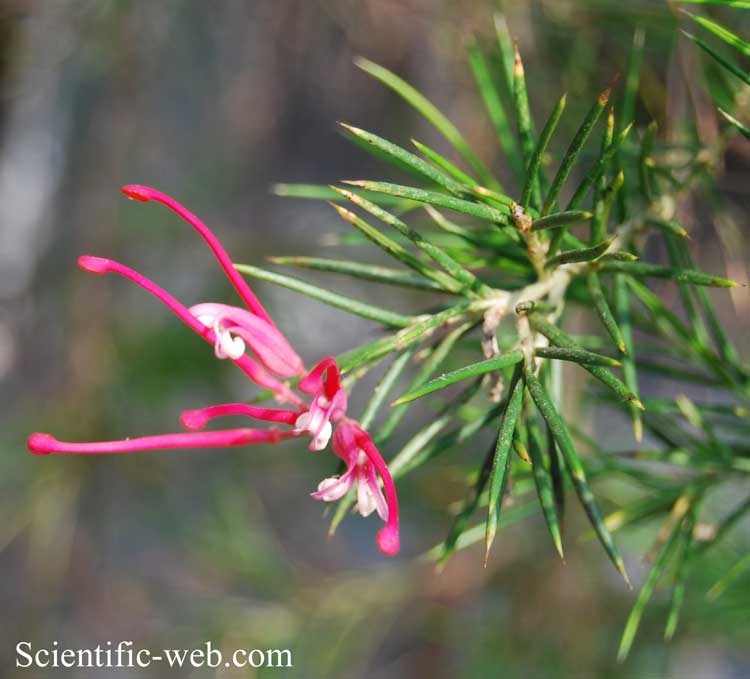
Grevillea rosmarinifolia, Photo: Michael Lahanas
Classification System: APG IV
Superregnum: Eukaryota
Regnum: Plantae
Cladus: Angiosperms
Cladus: Eudicots
Ordo: Proteales
Familia: Proteaceae
Subfamilia: Grevilleoideae
Tribus: Embothrieae
Subtribus: Hakeinae
Genus: Grevillea
Species: Grevillea rosmarinifolia
Subspecies: G. rosmarinifolia subsp. glabella - G. rosmarinifolia subsp. rosmarinifolia
Name
Grevillea rosmarinifolia A.Cunn.
References
B. Field, Geogr. Mem. New South Wales 328, cum t. 1825
USDA, ARS, Germplasm Resources Information Network. Grevillea rosmarinifolia in the Germplasm Resources Information Network (GRIN), U.S. Department of Agriculture Agricultural Research Service. Accessed: 08-Apr-12.
Vernacular names
English: Rosemary Grevillea
Grevillea rosmarinifolia, the rosemary grevillea, is a plant of the family Proteaceae.
Description
Grevillea rosmarinifolia usually occurs as a small to medium sized shrub 0.3–2 m (0.98–6.56 ft) high. The greater size is achieved in milder districts.[2]
The leaves resemble rosemary - narrow-linear, stiff with sharp points and curled-under margins, 0.8-3.8 cm long and 0.7–3 mm wide.[3]
Grevillea rosmarinifolia produces clusters of red or pink flowers from winter to spring.[2] The flowers are rich in nectar and attract nectarivorous insects and birds.
Taxonomy
It was first described by Allan Cunningham, an English botanist on an expedition in New South Wales. There are two currently recognised subspecies:[4]
Grevillea rosmarinifolia subsp. glabella (R.Br.) Makinson (Rankins Springs grevillea[5])
Grevillea rosmarinifolia subsp. rosmarinifolia (A.Cunn.)
Distribution and habitat
It is native to New South Wales and Victoria, Australia, and has naturalised in South Australia.
Grevillea rosmarinifolia prefers full sun. It is drought tolerant and hardy down to −10 °C (14 °F).[6]
Cultivation
Grevillea rosmarinifolia is cultivated as an ornamental plant, for use in gardens and drought tolerant landscaping. In the UK it has gained the Royal Horticultural Society’s Award of Garden Merit.[6][7]
Cultivars
See also: List of Grevillea cultivars
A large number of cultivars of the species have been selected, including:
"Anakie', a form from Anakie, Victoria
'Aromas', a form cultivated in the USA
'Aurea'
'Coral'
'Desert Flame'
'Hurstbridge' — a form from Hurstbridge, Victoria
'Jenkinsi'
'Lara Dwarf' (Lara form) — a form from Lara, Victoria, now extinct in the wild
'Lime-Light'
'Little Desert' — a form from the Little Desert in Victoria
'Lutea'
'Marlow'
'Nana'
'Nectis'
'Noelli' — a form cultivated in the U.S.
'Pink Pixie'
'Rosy Posy' — a form from the Yarrangobilly Caves area in New South Wales
'Vectis'
'Wakehurst'
'West Wyalong Beauty'
'Williamsii Prostrate'
'Williamsii'
'Wyalong Wonder'
References
"Grevillea rosmarinifolia". Australian Plant Name Index (APNI), IBIS database. Centre for Plant Biodiversity Research, Australian Government, Canberra. Retrieved 2010-06-07.
"Grevillea rosmarinifolia". Australian Native Plants Society (Australia) - ANPSAz. 11 November 2007. Archived from the original on 18 September 2009. Retrieved 2009-06-25.
"Grevillea rosmarinifolia A.Cunn". Royal Botanic Gardens & Domain Trust, Sydney Australia. Retrieved 2009-06-25.
"Grevillea rosmarinifolia". Flora of Australia Online. Department of the Environment and Heritage, Australian Government.
Newsletter No. 61, Grevillea Study Group, Association of Societies for Growing Australian Plants, March 2002, 'Vic Activity Reports: Field Trip to Riverina', page 3.
"RHS Plantfinder - Grevillea rosmarinifolia". Retrieved 16 February 2018.
"AGM Plants - Ornamental" (PDF). Royal Horticultural Society. July 2017. p. 43. Retrieved 2 March 2018.
Retrieved from "http://en.wikipedia.org/"
All text is available under the terms of the GNU Free Documentation License

